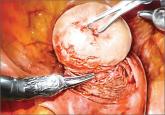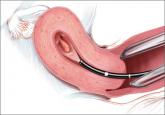News
The new year brings refinements to CPT and Medicare codes
New codes, deleted codes, and clarification of just who is a qualified health-care provider are some of the changes that occurred on January 1,...
Melanie Witt, RN, CPC, COBGC, MA, is an independent coding and documentation consultant and former program manager, department of coding and nomenclature, American Congress of Obstetricians and Gynecologists.
Ms. Witt reports no financial relationships relevant to this article.

Dr. Gerard recommends that additional views of the mass be obtained and that a CA 125 test be performed due to Mary’s family history of ovarian cancer. He also recommends that Mary be sent for a consultation with a gynecologic oncologist as soon as possible. The total time spent on this consultation is 15 minutes, and Dr. Gerard reports Mary’s consultative session to her insurance company with CPT code 99447.
Image-guided drainage of a fluid collection
CPT code 10030 has been added to report image-guided drainage of a fluid collection using a catheter for areas just under the skin. This code would be used if the patient had an abscess, hematoma, seroma, lymphocele, or cyst that was drained percutaneously. For instance, this code could be reported for a hematoma located in the abdominal wall or just under the skin. The code bundles image guidance, but it can be reported more than once if there is more than one collection drained with a separate catheter.
CPT also has added additional codes for image-guided fluid collection drainage by catheter (eg, abscess, hematoma, seroma, lymphocele, cyst) of visceral, peritoneal, or retroperitoneal collections. The codes for these procedures are:
49405...; visceral (eg, kidney, liver, spleen, lung/mediastinum), percutaneous
49406...; peritoneal or retroperitoneal, percutaneous
49407...; peritoneal or retroperitoneal, transvaginal or transrectal
With the addition of these new codes, the old code 58823 has been eliminated.
Uterine fibroid treatment
There are two changes with regard to the treatment of uterine fibroids. First, CPT code 37210 (Uterine fibroid embolization [UFE, embolization of the uterine arteries to treat uterine fibroids, leiomyomata], percutaneous approach inclusive of vascular access, vessel selection, embolization, and all radiologic supervision and interpretation, intraprocedural roadmapping, and imaging guidance necessary to complete the procedure) has been eliminated and replaced by a more general code that will apply to any tumor or organ. This new code is 37243 (Vascular embolization or occlusion, inclusive of all radiological supervision and interpretation, intraprocedural roadmapping, and imaging guidance necessary to complete the intervention; for tumors, organ ischemia, or infarction).
Second, there is now a Category III code for the laparoscopic ablation of uterine fibroids: 0336T (Laparoscopy, surgical, ablation of uterine fibroid[s], including intraoperative ultrasound guidance and monitoring, radiofrequency). Clinical research has shown that radiofrequency ablation (RFA) is effective in treating fibroids, resolving associated symptoms in more than 80% of treated patients. Because RFA is not yet a standard of care, this Category III code must be reported in order for data on its use to be collected. Under CPT rules, you may not use an unlisted code in place of the Category III code for this procedure. If you are performing RFA, it may be considered experimental by some payers, but you can still make a case for payment with the submission of adequate documentation with the claim in the form of peer-reviewed articles and the patient’s circumstances that preclude more standard surgeries.
Anogenital examination coding
Code 99170 was revised to reflect current practice. The procedure is not always performed with a colposcope, but usually requires digital imaging for legal recoding and documentation. The revised code reads “anogenital examination, magnified, in childhood for suspected trauma, including image recording when performed.” Moderate sedation, if performed, may be billed separately using code 99143-99150.
LABORATORY CODE CHANGES
Cell-free DNA testing code added
As of January 1, there is a new code to report cell-free prenatal DNA testing to screen for fetal aneuploidy. This new code is 81507 (Fetal aneuploidy [trisomy 21, 18, and 13] DNA sequence analysis of selected regions using maternal plasma, algorithm reported as a risk score for each trisomy).
Related Article: Update on Obstetrics Jaimey Pauli, MD, and John T. Repke, MD (January 2014)
In addition, the code 84112, which used to be defined as “placental alpha microglobulin-1 (PAMG-1), cervicovaginal secretion, qualitative,” has been revised. The revision was done to make it clear that it can be ordered for other proteins that are tested in amniotic fluid. Code 84112 is now defined as follows: Evaluation of cervicovaginal fluid for specific amniotic fluid protein(s) (eg, placental alpha microglobulin-1 [PAMG-1], placental protein 12 [PP12], alpha-fetoprotein), qualitative, each specimen.
This test is normally ordered to determine whether the fetal membranes have ruptured, but this is not a Clinical Laboratory Improvement Amendments (CLIA) waived or Provider Performed Microscopy Procedures (PPMP) test. Therefore, only the laboratory with the applicable CLIA certificate can bill for it.
There are now two code options for T vaginalis testing
To the existing code 87660 (direct probe technique) is added the new code 87661, T vaginalis, amplified probe technique.
New codes, deleted codes, and clarification of just who is a qualified health-care provider are some of the changes that occurred on January 1,...

With robotic assistance, a surgeon can reduce blood loss, shorten hospitalization, and ease laparoscopic suturing and knot-tying—but myomectomy is...

